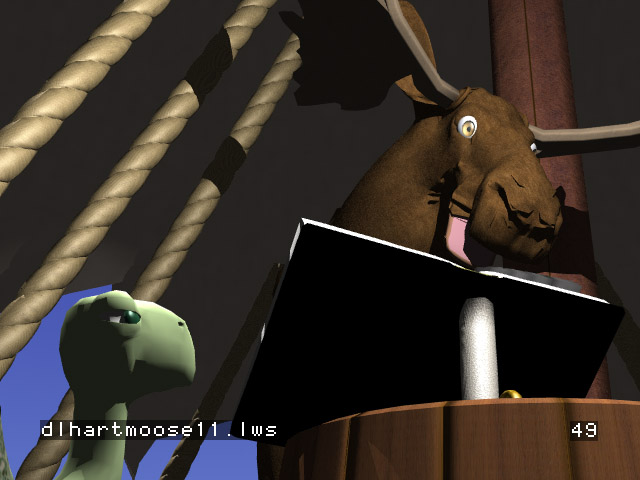|
|
|
GALLERY CONTINUED
PAGE THIRTY-EIGHT


Once again, we relied on Kursad Karatis's tip for working with emerging models -- paint box what you have to help the previsualization come together.

Oh yes, and if you are going to do eyes with a head that is rigged with bones, what you gain in bending and twisting, you will have to give back in improvisation. In the image above, the moose has turned his head using bones, and since the eye is merely parented to the head, the eye just floats in space. Just parenting the eyes to the moose isn't going to do it with INSPIRE. For rehearsal purposes, I DO use a moose with eyes, but they don't move.
I can live with the inconvenience of having to reload the two eyes and tongue and possibly hair to a separate object, and then bones "Replace Object" them to the scene file with the Moose bones rig. The only tedium comes from having to rig the eyes and tongue for bones, and since the bones will have to be in the resulting model, doing this rigging as part of the Moose model.
Confusing?
A little. With the current LIGHTWAVE and the other high-end packages, this kind of work is laughable. But when LIGHTWAVE 5.6 premiered the slight inconvenience of having to load one character's bones to two sets of objects seemed a small enough price to pay for the result of full animation.
Since this model's eyes do not use any texture maps, it seemed worth making a few morph targets of the Moose JUST for the eyes. Sometimes morphing is impractical with so many interleaving planes, but I gave it a try. And it worked. Morphing the eyes has one drawback -- getting good facial expressions around the eyes will require morphing those poses too. Morphing blinking, squinting, disbelief - in other words, animation. All those poses will largely have to be modelled. From what I hear, the animators at Disney and the other studios stick with face shape morphing instead of bonesing faces.
When a morph pose doesn't work it may turn the object into a horrible casserole of polygons that will take forever to render. To reduce this likelihood, keep as many points in identical places as possible. Just as there seems to be a convention of making models "treeform" (one expert advises there be some slight bend at joints, which sounds right), there seems to be a convention of making face models with eye and mouth sacks. If one is going to animate eyes and gestures as "face-shapes" and forget about the puppetry approach, then having eyes in eye sacks is going to simplify the calculations involved in morphing. Less casserole for dinner.
The model below did not use eye sacks because it did not occur to me, with the result that there were some problems making the character blink. A "Blink" object is apparently better at the end of a sequence of morphs than the middle, because after the blink pose, the point list was too much of a muddle for the morph to sort out, and the eyebrows wound up halfway up the forehead.
The goal is a moose head that moves all over the place talking while walking. One other way of achieving this is to make the twisting head the MAIN bone (like the pivot point), so that when the head/neck twists, the body is doing the twisting. Maybe useable with a fast moving character, the legs will rarely touch the ground using this method, and it is probably going to be counter-intuitive. I have seen some fairly stiff models that apparently did this. If you want to see both approaches, check out the latest holiday specials.

I use "Hide" a lot when polygonal texturing. I just grab the area I need, then "Hide Unselected" everything else. This was one of the first characters where a transition zone was added between two textures. The neck/face zone can be picked-out if you look at the preceding image. Borrowing the base color from the destination zone, and choosing an opacity between the two values gave a fair transition. I rarely use a texture full strength.
I added ersatz hair which was created by tugging every fourth point of a subdivided card, with the resulting spikes jittered and "knifed." The same "haircard" was later used for the eyelashes as well.
< BACK . . . . . . . . . . . . . . < HOME > . . . . . . . . . . . . . . NEXT >